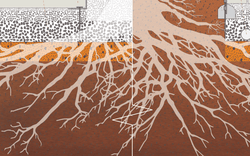Correlating Happiness
Wendy Chun and Orit Halpern on measuring happiness
Wendy Chun and Orit Halpern met to discuss today’s practice of measuring “happiness” and its implications. They begin by considering the etymological root of “happy,” a term that derives from “hap”—as in luck or fortune.
- OH
- So let’s start with this idea that “happiness” is a question of luck. What does that denote in terms of thinking—at national, urban, and other scales—both governmentally and politically? If the state is measuring “happiness,” is it the role of the state to somehow manage luck? I would say that means somehow managing risk or facilitating forms of speculative behaviour. So is the push toward “happy” an effort to make people more ready to take risks? Perhaps more ready to deal with precarity?
- WC
- Yes, but if happiness is now measured via certain indices, it implies that happiness has very little to do with luck or chance. For instance, if happiness is correlated in these measures to government politics, this implies that “right” government policies will produce happiness. This poses the questions: who or what is deemed responsible for happiness? And to what extent do happiness rankings translate probabilities into facts, so that chance in fact disappears?
- OH
- I think that’s a provocative statement, but I’d like to go back to your first question about responsibility. When you start thinking about happiness as probability or chance, a scalar question emerges about how individuals are being managed or encouraged to be happy. Does this align or not align with more structural changes happening in the state or in urban development? I wonder if this means a kind of democratization of chance or of probability…
- WC
- How is it democratization?
- OH
- A democratization of probability—of speculative practices—in which people are being encouraged to embrace certain forms of uncertainty in the hope that they’ll play the game and win.
Our Happy Life talks about Britain and France, two countries that ten years ago introduced this idea of measuring happiness and are now undergoing considerable social unrest around questions of social inequity. It’s almost glaring that something like this would suddenly come up as the state starts to offset the forms of insurance that it used to provide, from welfare systems on to individual practice. Now, to see yourself as happy is to see yourself as an individual with luck, who is able to game the system. A happy, or lucky, person is now someone ready to take risks and face uncertainty, or precarity. For example, they may “happily” endure conditions like not having a permanent job or being unionized or health-insured. - WC
- I think what you’re pointing to is an operationalization of happiness that both erases and presumes luck by making individuals seem responsible for their own luck. Here, I draw from Oscar Gandy’s work in Coming to Terms with Chance. He looks at the ways in which racial inequality has been instrumentalized and accepted within the US within the rubric of luck. He studies the forms of discrimination that underlie luck, that make members of certain races routinely seem unlucky. Why have some races been routinely viewed as insurable and others, not? A democratization that presumes some are happier than others is also a separation of populations, right?
The move to measure happiness adds another layer. Rather than framing some people as luckier than others—which implies providence but also chance—it implies that being happy makes you lucky. Do you see the reversal that happens? Once you make happiness an index—and here, it doesn’t have to be tied to countries, you can imagine an individual measure based on various correlated aspects—you become responsible for your luck instead of luck being responsible for your happiness. - OH
- I really like this idea of both the erasure and the presumption of luck as being inherent in this concept of happiness, because it is precisely structural features that make people lucky, right? It’s not lucky that one attends Harvard if one is of a certain class, race, or et cetera; but the presumption of luck around the question of “are you happy” as a hold-in for those other categories erases the structural features of luck. This then becomes also interesting in how it legitimizes older histories of racism, sexism, xenophobia, et cetera in the implication that people are not successful because they’re unlucky or unhappy and that that’s the cause of their misery.
- WC
- And that is what’s interesting about going to this etymology, because it actually brings out the fact that if you’re lucky, you’re happy; as opposed to if you’re happy, you’re lucky.
- OH
- I worked in international development for a lot of years, and one of the things that annoyed me most was this attitude that people in “the villages” are both simple and happy because they don’t have the problems of urbanization. It’s kind of an inverted model—poverty doesn’t necessarily make you unhappy and at the same time, there’s an erasure of the feature of poverty that makes you unhappy. The attitude omits an acknowledgment of a transformed approach to happiness…
- WC
- And these groupings—rich and stressed, poor and simple—become ways to segment populations. They place people within homophilous bubbles with others that are structurally in the same situation. When you’re in this bubble, you don’t see how your situation varies drastically or not from others.
Oscar Gandy describes how people’s life experiences vary radically according to what group they’re sorted into. Consider airport security. If you are decided to be low-risk, you sail through while others go through secondary inspection, intrusive searches, et cetera. And if you’re only amongst those deemed to be “like” you, you miss how your experience varies from others. Because of this, small deviations, often attributed to luck, are perceived to be much larger.
It’s interesting to consider this in terms of the segregation of populations. Once you are in a population that has been separated out, a small situational difference suddenly seems huge and you feel unlucky. - OH
- This is similar to the way we compare growth indicators between places. If a city has a smaller population, a small increase may seem comparatively more significant, and this, of course, affects policy and impressions about improvement or change.
I guess what holds in real estate, holds in happiness as well. Perhaps real estate and happiness are joined. These forms of segregation by population have a territorial implication, particularly if we’re talking about the distribution of happiness and the probability of whether one can get insured, get a home mortgage, or just get more access to services that might improve their condition. Building for happiness is also about the spatial distribution and splitting of populations. - WC
- This raises the idea that housing projects were and are forms of social engineering. If you go to the origins of homophily research, Paul Lazarsfeld and Robert Merton (who coined the term in 1954) were investigating housing projects and observing friendship patterns within them. They conclude that the most important determinant of a housing project’s success is tenant morale, which is another version of happiness. They argue that there are structural things—propinquity, physical architecture, the relationship between the interior and exterior—that are central to the formation of tenant morale. They also contend in very complicated and disturbing ways that the biracial nature of one project, which was biracial but segregated, negatively affected the morale of white residents—this was 1948.
I think that further work into the relationship between homogeneity and perceptions of happiness is important. Let’s look at the 2019 happiest countries in the world: Finland, Denmark, Norway, Iceland…you see? - OH
- Well, this comes back to a question about the feedback loop between how you’re measuring and the conditions under which you are measuring happiness, care, or comfort—which as you mention emerges from a long history of sociology and eugenics. Donald Hebb, who was a psychologist from McGill, criticizes the thinking behind Binet’s IQ test and the assumption, inherent in the test, that you could give people an IQ test in a standardized way. Hebb believes that our mental capacities and psychologies are formed through experience, so it becomes impossible to perform a standardized test of ability, because that would assume that we all share similar experiences. This relates to the Lazarsfeld-Merton conception of what is considered to be comfortable or better for the community, and these integrated psychologies of architecture have a long history in modernity. Architects have always been obsessed with psychoanalysis and other forms of psychology in order to think about the building in terms of how it affects your internal state. They should really be questioning the standards themselves, by which we measure environmental impacts on well-being.
- WC
- The World Happiness Report measures positive affect against negative affect, but if you look at the initial definitions of happiness as posited by the survey, happiness is about contentment, which would seem to be neither positive nor negative. This question is interesting, because in Lazarsfeld and Merton’s work on the housing project and their measure of homophily, they not only ignore the responses of all black residents, they also bracket out the responses of white residents who were ambivalent—and thus you could say content. To measure homophily, they drew from three questions in their one-hundred-question questionnaire: 1, do you think housing projects should be integrated? 2, do you think black and white residents get along in the housing project? And 3, who are your three closest friends? They considered you liberal if you answered yes to 1 and 2; illiberal if you answered no to 1 and 2; and ambivalent if you answered no to 1 but yes to 2. They ignored all the black responses because they said there weren’t enough black illiberals or ambivalents. Again, they also ignored the white ambivalents, who comprised the largest group. The illiberals were a very small category and the overwhelming majority of residents believed that the races got along well. So how can you think through happiness in relationship to neither positive nor negative affect? What about neutral affect?
- OH
- There’s a quick move from contentment to the term satisfaction—it moves away from affect to a more behavioural or, for lack of a better term, consumerist understanding of what happiness might denote. They’re asking people, “are you satisfied with your partner?” and you get to say, “yes, no”—which is really different from being asked, “how do you feel about them today?”
- WC
- And we’ve moved from morale to happiness. The mid-twentieth century was about morale, and morale wasn’t simply about happiness; it was also about civic engagement. How could you measure civic engagement? So what does it mean to move from morale to happiness?
- OH
- Tracing the news, at least in the US, there seems to be a politics of extremely strong emotions and not a politics of contentment. And then there’s the argument that unhappy people are more likely to vote for populists. So this becomes a kind of further exemplar of moving toward the moral rather than the recognition that there may actually be questions in civic space around how we deal with heterogeneity. What are the stakes in this moralization (even on the left) of political actions or choices?
- WC
- So homophily was coined as a sociological concept in the mid-20th century but really took off much later, due to collaborative filtering and other forms of network building. Homophily erases racism and hate and instead talks about “natural” love. Under homophily, if there is discrimination, it’s because people love people who are like themselves. But how do you show you love people like yourself? By leaving when others show up. Homophily covers over institutional responsibility through a banal agent-based system.
If that’s what homophily does, then what is the politic of using happiness as a measure? - OH
- It’s like proxy indicators in public health. Zip code, income level, this, that, collectively recreate a population that would be reached if those groups were asked about race. Indicators begin to align in a similar way—without having to say, “Okay, you’re from a southern state, and you’re white, and you’re a guy,” we can now say, “Okay, you have these sentiments.” Sentiments replace structural or historical social conditions.
- WC
- It’s all correlation, so then the question becomes: how is the correlation interpreted, and what does the correlation reverse? To say two things are correlated—to say that happiness is a correlation for x or y—is to not only ask the question of why they correlate, but also to ask the question: to what extent does the correlation reverse the causality?









